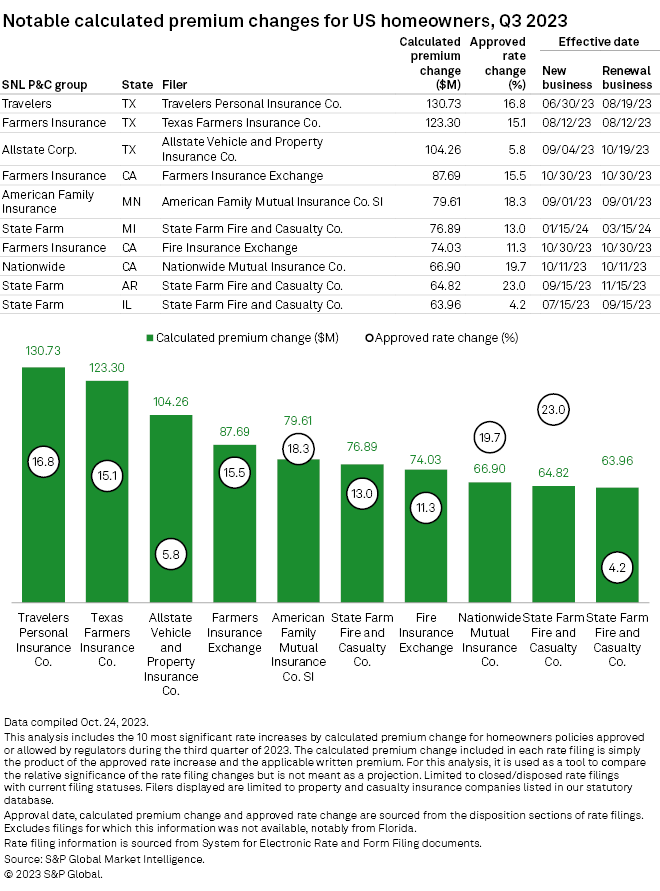S&P Global Offerings
Featured Topics
Featured Products
Events
S&P Global Offerings
Featured Topics
Featured Products
Events
S&P Global Offerings
Featured Topics
Featured Products
Events
Banking & Capital Markets
Economy & Finance
Energy Transition & Sustainability
Technology & Innovation
Podcasts & Newsletters
Banking & Capital Markets
Economy & Finance
Energy Transition & Sustainability
Technology & Innovation
Podcasts & Newsletters
S&P Global Offerings
Featured Topics
Featured Products
Events
31 Oct, 2023
By Noor Ul Ain Adeel
Texas regulators signed off on 36 double-digit rate increases in the third quarter, three of which were the most-impactful hikes in the entire US during the period.
According to an S&P Global Market Intelligence analysis, the most-impactful homeowners rate change in the quarter was a 16.8% increase granted to The Travelers Cos. Inc.'s Travelers Personal Insurance Co. subsidiary with a calculated premium change of $130.73 million. That hike is expected to impact 370,000 policyholders.
In total, Travelers subsidiaries received approvals for 34 significant homeowners rate increases, almost a third of them in excess of 10%. All told, rate changes in the third quarter are expected to increase Travelers' premiums by $269.2 million.
Regulators signed off on 82 rate increases for Farmers Insurance Group of Cos., which stand to boost its aggregate premiums by $513.7 million. The insurer's most-impactful rate increase was a 15.1% rate change for Texas Farmers Insurance Co. In California, Farmers Insurance Exchange received approval for a 15.5% rate hike that will impact roughly 382,000 policyholders.
The Allstate Corp. received approvals for 51 rate hikes during the third quarter, the most significant of which was a 5.8% increase for Allstate Vehicle & Property Insurance Co.

 |
– Learn about P&C insurers' earnings performance in the second quarter – Download a template to analyze rate changes for selected entities, states or type of insurance over a selected period. |
Liberty Mutual gets
A number of Liberty Mutual Holding Co. Inc. units got approval to boost homeowners rates in excess of 20% on books of business worth $20 million or more.
Battle Creek Mutual Insurance Co., a subsidiary of Nodak Mutual Group Inc., received the largest rate hike in the quarter, on a percentage basis, on a book of business worth $20 million or more. Nebraska regulators approved a 39.9% rate increase for Nodak Mutual. The new rates will take effect Nov. 1 for both new and renewal business, and will affect more than 11,000 policyholders.


All figures listed are based on as-reported numbers filed in the rate filings of each subsidiary in each state. The calculated premium change is not a final projection of the additional premium the insurer may receive in the upcoming year. The calculated premium change is reported by each insurer to reflect the most impactful premium changes based on the combined impact of the percentage change and the amount of business it affects. Changes to the insurer's policy mix or policies in force are not factored into the analysis.
US states employ a variety of rate regulation mechanisms, including prior approval, modified prior approval, file and use as well as use and file. Some states do not require explicit regulatory approval prior to insurers using new rates. This analysis is based on when rate filings are "disposed" by state regulators and does not take into account when those new rates became effective for new and renewal business. In some instances, a new rate may have been in effect prior to the month the filing was approved by the regulator.

